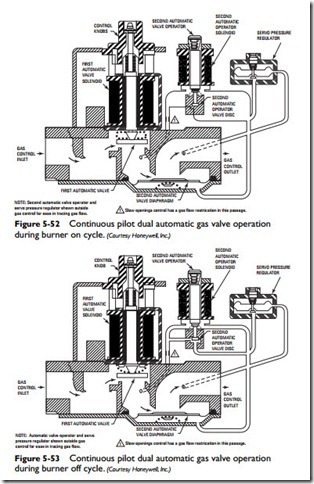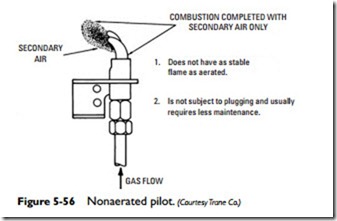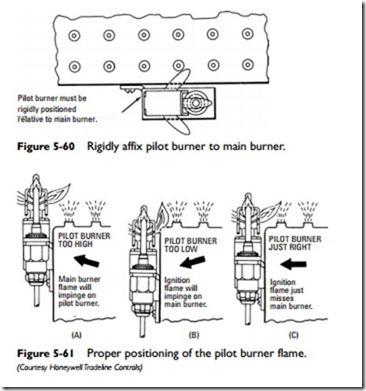Universal Electronic Ignition Combination Gas Valve
The Honeywell universal electronic ignition combination gas valve shown in Figure 5-54 is designed for use with intermittent-spark ignition, direct-spark ignition, and hot-surface ignition systems in 24 VAC gas furnaces and boilers. This combination gas valve includes a manual valve, two automatic operators, pressure regulator, pilot adjustment, pilot plug, and ignition adapter.
Pilot Burners
A pilot burner is a device used in a gas-fired appliance to light the main gas burners and generate sufficient millivoltage to operate a thermocouple or thermopile pilot safety shutoff device (see Automatic Pilot Valves in this chapter). Modern pilot burners are designed to burn continually in order to provide an automatic ignition of the burners when the main gas supply is turned on.
The pilot burners in common use today can be divided into aerated and nonaerated types.
An aerated pilot (see Figure 5-55) is one that injects primary air through an air intake opening into the gas stream. The air and gas are mixed before burning.
An aerated pilot burner produces a very stable flame. For this reason, these pilots are often used where the pilot location is particularly inaccessible. Although the flame produced by an aerated pilot burner is more stable than one produced by a nonaerated type, an aerated pilot burner does have some disadvantages. An important one to remember is the tendency for the small primary air openings to clog with lint and dirt. Frequent cleaning is required, particularly when these pilots are used in areas having a large amount of foreign material in the air.
1. More stable than non-aerated pilot.
2. Primary air openings can plug with lint and dirt, requiring frequent cleaning.
A nonaerated pilot (see Figure 5-56) does not inject primary air. As a result, the air and gas are not premixed, and the combustion process must be completed with secondary air only. This results in a less-stable flame than the one produced by an aerated pilot. On the credit side, a nonaerated pilot requires less maintenance than an aerated pilot. For this reason, the nonaerated pilot burner is usually preferred by most utility companies.
A pilot burner assembly consists of the pilot bracket, pilot ori- fice, primary air intake, lint screen, mixing chamber, pilot ports, and pilot hood.
The pilot bracket is a device used to mount the pilot in a fixed rela- tionship to the burner. Some pilot brackets also contain means for mounting the thermocouple or pilot generator so that the hot junction is located directly in the path of the pilot flame (see Figure 5-57).
The pilot ports are the openings through which the gas (in non- aerated pilot burners) or the gas and air mixture (in aerated pilot burners) passes before burning. The gas and air are premixed in the mixing chamber of an aerated pilot. The air is injected into the mixing chamber of an aerated pilot through a hole or opening called the primary air intake. The amount of primary air can be controlled by adjusting an air shutter that covers the primary air intake opening.
A lint screen is generally used to remove lint, dirt, and other con- taminants from the primary air before it enters the primary air opening. In some pilots, the lint and other particles are burned
before entering the primary air intake. An incinerated pilot is an aerated pilot in which the primary air passes adjacent to the flame area where the particles are burned out of the air before it enters the primary air intake.
Impurities are also found in the pilot gas. These impurities can be removed by installing a pilot gas filter in the line upstream from the pilot adjustment means in the control. The pilot gas filter is expected to operate several years without service. Clogging of the filter will be indicated by shortened pilot flames, which will result in improper pilot operation. Shortened pilot flames can also be caused by pilot tube stoppage or a dirty pilot orifice. These possi- bilities should be checked before removing the filter. If the filter should become clogged, replace the entire filter rather than just the filtering medium.
The pilot orifice is a removable component in the pilot that con- tains precisely sized openings that control the admission of gas to the pilot. Pilot orifices are either of the spud or insert type. A spud orifice screws into the bottom of the pilot burner. It is both an ori- fice and a fitting combined into a single unit with threads at either end (see Figure 5-58). An insert orifice must be held in position by a separate fitting (see Figure 5-59). The pilot gas line (tubing) is connected to the bottom of the pilot orifice.
Installing a Pilot Burner
Always follow the manufacturer’s instructions when installing a new pilot burner. Read these instructions very carefully before beginning any work.
If no installation instructions are available, the following loca- tion and mounting requirements should be carefully observed:
1. Choose a location for the pilot burner that provides easy access, observation, and lighting.
2. Rigidly affix the pilot burner to the main burner. Other mounting surfaces should not be used (see Figure 5-60).
3. Mount the pilot burner so that the flame is properly positioned with respect to the main burner flame (see Figure 5-61).
Pilot burner must be rigidly positioned relative to main burner.
A pilot flame should never be exposed to falling scale, which could impair the ignition of the main burners. Furthermore, the flame should not be exposed to draft conditions or to sudden puffs of air sometimes caused by igniting or extinguishing the main burner. Always provide an ample air supply free of contaminating products of combustion.





